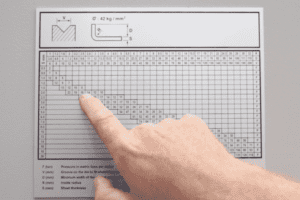Here is our guide explaining how to work out V sizes and how to work out the tonnage required to fold the material on a metalworking pressbrake. On the side of all our machines we have a chart that shows you the different tonnage options but first we show you how to understand the size of the V that is required.
The calculation that you need to grasp is: 6-8 times material thickness equals the size of the V up to 3mm. 10-12 times material thickness will equal the size of the V above 3mm.
In this video, we demonstrate several examples to illustrate this calculation. Let’s say we’re folding 2mm and we times it by 6. This means we need a 12mm V. On the chart on the side of the machine, if you look at the 2 and you look at the 12, and you bring them together at the joining point, it tells you that you need 23 tons per linear meter.
If we were folding 10mm plate, we times it by 10, we would need a 100mm V. Looking at the chart again at these two points and following it across to where they join it shows us that you would need 59 tons per linear meter to fold 10mm plate.
Watch this video to see step by step how to work out the V size and tonnage required to fold your material on a pressbrake.
Published 4th July 2016

